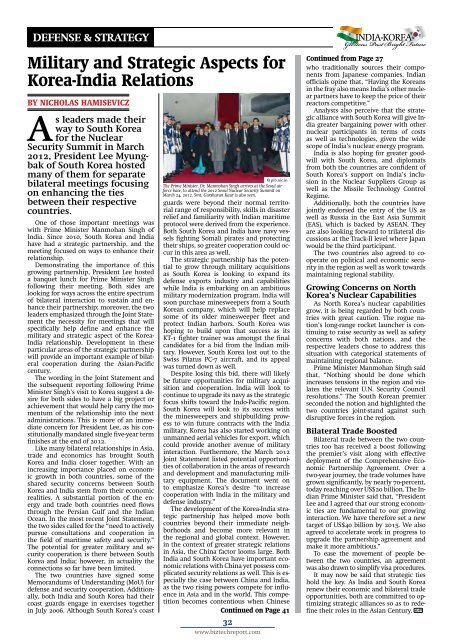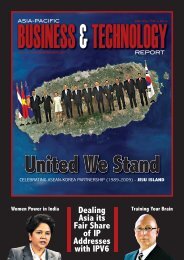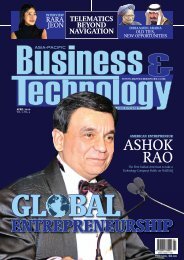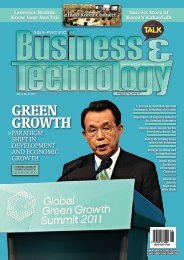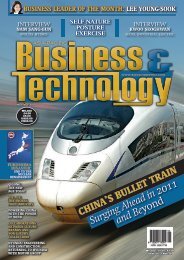INDIA-KOREA - Asia-Pacific Business and Technology Report
INDIA-KOREA - Asia-Pacific Business and Technology Report
INDIA-KOREA - Asia-Pacific Business and Technology Report
Create successful ePaper yourself
Turn your PDF publications into a flip-book with our unique Google optimized e-Paper software.
Defense & STRATEGY<br />
Military <strong>and</strong> Strategic Aspects for<br />
Korea-India Relations<br />
By Nicholas Hamisevicz<br />
As leaders made their<br />
way to South Korea<br />
for the Nuclear<br />
Security Summit in March<br />
2012, President Lee Myungbak<br />
of South Korea hosted<br />
many of them for separate<br />
bilateral meetings focusing<br />
on enhancing the ties<br />
between their respective<br />
countries.<br />
One of those important meetings was<br />
with Prime Minister Manmohan Singh of<br />
India. Since 2010, South Korea <strong>and</strong> India<br />
have had a strategic partnership, <strong>and</strong> the<br />
meeting focused on ways to enhance their<br />
relationship.<br />
Demonstrating the importance of this<br />
growing partnership, President Lee hosted<br />
a banquet lunch for Prime Minister Singh<br />
following their meeting. Both sides are<br />
looking for ways across the entire spectrum<br />
of bilateral interaction to sustain <strong>and</strong> enhance<br />
their partnership; moreover, the two<br />
leaders emphasized through the Joint Statement<br />
the necessity for meetings that will<br />
specifically help define <strong>and</strong> enhance the<br />
military <strong>and</strong> strategic aspect of the Korea-<br />
India relationship. Development in these<br />
particular areas of the strategic partnership<br />
will provide an important example of bilateral<br />
cooperation during the <strong>Asia</strong>n-<strong>Pacific</strong><br />
century.<br />
The wording in the Joint Statement <strong>and</strong><br />
the subsequent reporting following Prime<br />
Minister Singh’s visit to Korea suggest a desire<br />
for both sides to have a big project or<br />
achievement that would help carry the momentum<br />
of the relationship into the next<br />
administrations. This is more of an immediate<br />
concern for President Lee, as his constitutionally<br />
m<strong>and</strong>ated single five-year term<br />
finishes at the end of 2012.<br />
Like many bilateral relationships in <strong>Asia</strong>,<br />
trade <strong>and</strong> economics has brought South<br />
Korea <strong>and</strong> India closer together. With an<br />
increasing importance placed on economic<br />
growth in both countries, some of the<br />
shared security concerns between South<br />
Korea <strong>and</strong> India stem from their economic<br />
realities. A substantial portion of the energy<br />
<strong>and</strong> trade both countries need flows<br />
through the Persian Gulf <strong>and</strong> the Indian<br />
Ocean. In the most recent Joint Statement,<br />
the two sides called for the “need to actively<br />
pursue consultations <strong>and</strong> cooperation in<br />
the field of maritime safety <strong>and</strong> security.”<br />
The potential for greater military <strong>and</strong> security<br />
cooperation is there between South<br />
Korea <strong>and</strong> India; however, in actuality the<br />
connections so far have been limited.<br />
The two countries have signed some<br />
Memor<strong>and</strong>ums of Underst<strong>and</strong>ing (MoU) for<br />
defense <strong>and</strong> security cooperation. Additionally,<br />
both India <strong>and</strong> South Korea had their<br />
coast guards engage in exercises together<br />
in July 2006. Although South Korea’s coast<br />
© pib.nic.in<br />
The Prime Minister, Dr. Manmohan Singh arrives at the Seoul air<br />
force base, to attend the 2012 Seoul Nuclear Security Summit on<br />
March 24, 2012. Smt. Gursharan Kaur is also seen.<br />
guards were beyond their normal territorial<br />
range of responsibility, skills in disaster<br />
relief <strong>and</strong> familiarity with Indian maritime<br />
protocol were derived from the experience.<br />
Both South Korea <strong>and</strong> India have navy vessels<br />
fighting Somali pirates <strong>and</strong> protecting<br />
their ships, so greater cooperation could occur<br />
in this area as well.<br />
The strategic partnership has the potential<br />
to grow through military acquisitions<br />
as South Korea is looking to exp<strong>and</strong> its<br />
defense exports industry <strong>and</strong> capabilities<br />
while India is embarking on an ambitious<br />
military modernization program. India will<br />
soon purchase minesweepers from a South<br />
Korean company, which will help replace<br />
some of its older minesweeper fleet <strong>and</strong><br />
protect Indian harbors. South Korea was<br />
hoping to build upon that success as its<br />
KT-1 fighter trainer was amongst the final<br />
c<strong>and</strong>idates for a bid from the Indian military.<br />
However, South Korea lost out to the<br />
Swiss Pilatus PC-7 aircraft, <strong>and</strong> its appeal<br />
was turned down as well.<br />
Despite losing this bid, there will likely<br />
be future opportunities for military acquisition<br />
<strong>and</strong> cooperation. India will look to<br />
continue to upgrade its navy as the strategic<br />
focus shifts toward the Indo-<strong>Pacific</strong> region.<br />
South Korea will look to its success with<br />
the minesweepers <strong>and</strong> shipbuilding prowess<br />
to win future contracts with the India<br />
military. Korea has also started working on<br />
unmanned aerial vehicles for export, which<br />
could provide another avenue of military<br />
interaction. Furthermore, the March 2012<br />
Joint Statement listed potential opportunities<br />
of collaboration in the areas of research<br />
<strong>and</strong> development <strong>and</strong> manufacturing military<br />
equipment. The document went on<br />
to emphasize Korea’s desire “to increase<br />
cooperation with India in the military <strong>and</strong><br />
defense industry.”<br />
The development of the Korea-India strategic<br />
partnership has helped move both<br />
countries beyond their immediate neighborhoods<br />
<strong>and</strong> become more relevant in<br />
the regional <strong>and</strong> global context. However,<br />
in the context of greater strategic relations<br />
in <strong>Asia</strong>, the China factor looms large. Both<br />
India <strong>and</strong> South Korea have important economic<br />
relations with China yet possess complicated<br />
security relations as well. This is especially<br />
the case between China <strong>and</strong> India,<br />
as the two rising powers compete for influence<br />
in <strong>Asia</strong> <strong>and</strong> in the world. This competition<br />
becomes contentious when Chinese<br />
Continued on Page 41<br />
32<br />
www.biztechreport.com<br />
<strong>INDIA</strong>-<strong>KOREA</strong><br />
Glorious Past Bright Future<br />
Continued from Page 27<br />
who traditionally sources their components<br />
from Japanese companies. Indian<br />
officials opine that, “Having the Koreans<br />
in the fray also means India’s other nuclear<br />
partners have to keep the price of their<br />
reactors competitive.”<br />
Analysts also perceive that the strategic<br />
alliance with South Korea will give India<br />
greater bargaining power with other<br />
nuclear participants in terms of costs<br />
as well as technologies, given the wide<br />
scope of India’s nuclear energy program.<br />
India is also hoping for greater goodwill<br />
with South Korea, <strong>and</strong> diplomats<br />
from both the countries are confident of<br />
South Korea’s support on India’s inclusion<br />
in the Nuclear Suppliers Group as<br />
well as the Missile <strong>Technology</strong> Control<br />
Regime.<br />
Additionally, both the countries have<br />
jointly endorsed the entry of the US as<br />
well as Russia in the East <strong>Asia</strong> Summit<br />
(EAS), which is backed by ASEAN. They<br />
are also looking forward to trilateral discussions<br />
at the Track-II level where Japan<br />
would be the third participant.<br />
The two countries also agreed to cooperate<br />
on political <strong>and</strong> economic security<br />
in the region as well as work towards<br />
maintaining regional stability.<br />
Growing Concerns on North<br />
Korea’s Nuclear Capabilities<br />
As North Korea’s nuclear capabilities<br />
grow, it is being regarded by both countries<br />
with great caution. The rogue nation’s<br />
long-range rocket launcher is continuing<br />
to raise security as well as safety<br />
concerns with both nations, <strong>and</strong> the<br />
respective leaders chose to address this<br />
situation with categorical statements of<br />
maintaining regional balance.<br />
Prime Minister Manmohan Singh said<br />
that, “Nothing should be done which<br />
increases tensions in the region <strong>and</strong> violates<br />
the relevant U.N. Security Council<br />
resolutions.” The South Korean premier<br />
seconded the notion <strong>and</strong> highlighted the<br />
two countries joint-st<strong>and</strong> against such<br />
disruptive forces in the region.<br />
Bilateral Trade Boosted<br />
Bilateral trade between the two countries<br />
too has received a boost following<br />
the premier’s visit along with effective<br />
deployment of the Comprehensive Economic<br />
Partnership Agreement. Over a<br />
two-year journey, the trade volumes have<br />
grown significantly, by nearly 70-percent,<br />
today reaching over US$20 billion. The Indian<br />
Prime Minister said that, “President<br />
Lee <strong>and</strong> I agreed that our strong economic<br />
ties are fundamental to our growing<br />
interaction. We have therefore set a new<br />
target of US$40 billion by 2015. We also<br />
agreed to accelerate work in progress to<br />
upgrade the partnership agreement <strong>and</strong><br />
make it more ambitious.”<br />
To ease the movement of people between<br />
the two countries, an agreement<br />
was also drawn to simplify visa procedures.<br />
It may now be said that strategic ties<br />
hold the key. As India <strong>and</strong> South Korea<br />
renew their economic <strong>and</strong> bilateral trade<br />
opportunities, both are committed to optimizing<br />
strategic alliances so as to redefine<br />
their roles in the <strong>Asia</strong>n Century. A-P


